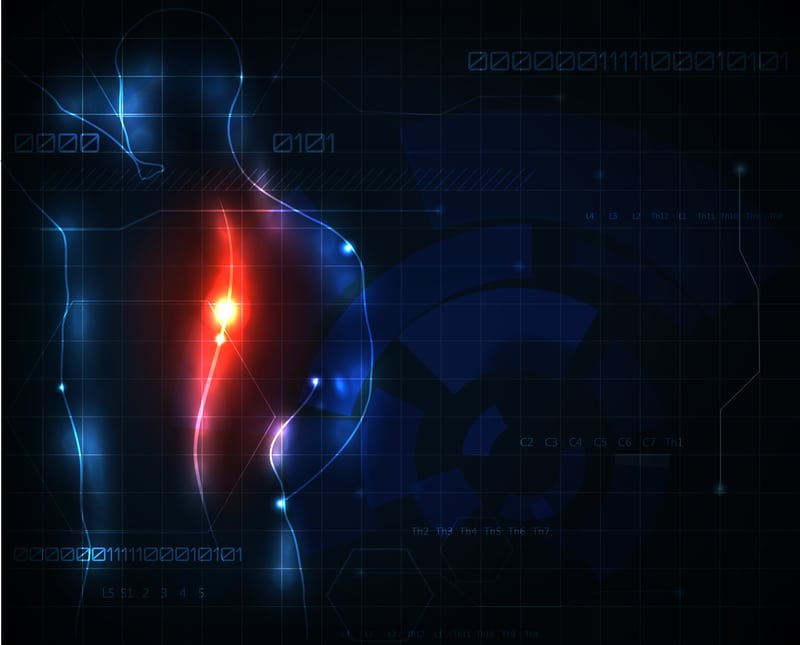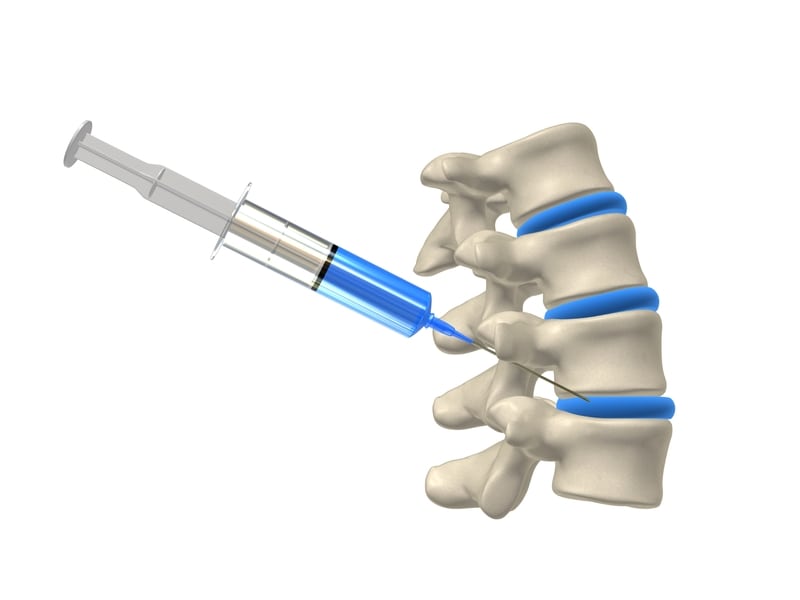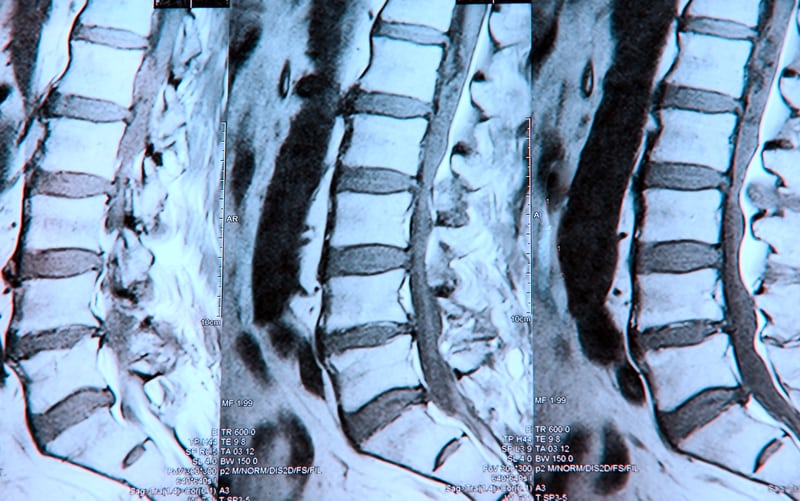 If you experience chronic pain, you may have heard about the use of injections for back pain. For some, the injection of a steroid and numbing agent is an effective treatment regimen to relieve back pain and inflammation. There are many reasons that a doctor may choose an injection as a pain intervention and not every person will experience the same relief.
If you experience chronic pain, you may have heard about the use of injections for back pain. For some, the injection of a steroid and numbing agent is an effective treatment regimen to relieve back pain and inflammation. There are many reasons that a doctor may choose an injection as a pain intervention and not every person will experience the same relief.
Injections for back pain are used to help treat two major back pain problems, spinal stenosis and radiculopathy, as well as other types of back pain. At times, these injections are also helpful in making a diagnosis for a patient’s pain.
In those that suffer from spinal stenosis, their lower spine becomes narrowed and compresses the nerves inside. Pain can be increased with activity and is typically noted in the buttocks, leg or back. Radiculopathy refers to damage or inflammation of a nerve typically in the neck or lower back. The origin of the pain is in the location where the nerve exits the spine. Sufferers can notice sharp pains that shoot from the lower back into one or both legs, or from the neck into an arm. This condition can be caused by a herniated disc.
 Your doctor can determine the best injection that will work for your back pain and your overall health.
Your doctor can determine the best injection that will work for your back pain and your overall health.
Epidural Injections
Prior to receiving an epidural injection, you may undergo a CT scan or MRI of your back so the doctor can identify the cause of your pain. The term epidural refers to the area around your spinal cord. These injections can be given in a doctor’s office or hospital setting. Light, conscious sedation may be used to treat anxiety related to the procedure and the injection area will be injected with a numbing anesthetic. A doctor will use live x-ray video to maneuver the needle into the epidural space, the space between the spine and spinal cord. The steroid medicine injected is called corticosteroid and typically it is accompanied by an additional anesthetic medication as well. The corticosteroid is time-released, providing lasting back pain relief.
Nerve Block Injections
During a nerve block, a doctor injects a numbing agent or anesthetic, typically lidocaine, into the area around the affected nerve. You may notice almost complete pain relief after this injection, but the extent of the numbness tends to wear off over several hours. Nerve block injections are also used by doctors to make a diagnosis as to the cause of your back pain. After undergoing the injections, your doctor may ask which one caused the pain to go away. The doctor may then choose to treat the affected nerve with an epidural injection using both a steroid and anesthetic medication.
Facet Joint Injections
 A facet is a small joint located at each segment of the spine. Their purpose is to provide stability to the area and help guide motion. Facet joints can create pain as a result of spinal arthritis, a back injury, or mechanical stress to the back. There are three areas that can be affected by painful facet joints; cervical, thoracic, and lumbar with pain noted in the following areas:
A facet is a small joint located at each segment of the spine. Their purpose is to provide stability to the area and help guide motion. Facet joints can create pain as a result of spinal arthritis, a back injury, or mechanical stress to the back. There are three areas that can be affected by painful facet joints; cervical, thoracic, and lumbar with pain noted in the following areas:
- Cervical – Pain typically felt in the head, neck, arm, and/or shoulder.
- Thoracic – Pain typically noted in the upper back, arm, and/or chest area.
- Lumbar – Pain typically experienced in the hip, lower back, buttock, and/or leg.
During a cervical, thoracic or lumbar joint injection, a small amount of a numbing agent and/or a steroid medication are injected into the painful area. This helps to anesthetize the facet joints and block associated pain. The doctor’s goal is that the patient will receive enough relief to tolerate a physical therapy routine to rehabilitate this painful condition.
Radiofrequency Facet Neurotomy/Rhizotomy
 Depending upon your doctor and your pain management program, if you undergo three facet joint injections that provide good relief on only a temporary basis, a facet neurotomy/rhizotomy may be recommended. During this procedure, a needle with a probe is inserted just outside the joint. Radio waves are then used to heat the probe, which is then applied to the joint’s sensory nerve causing it to be disabled. The theory is that by disabling the sensory nerve of a facet joint, pain signals will be prevented from reaching the brain. The purpose of this injection for back pain is to provide long-lasting low back pain relief, with approximately 50 percent of patients achieving treatment success.
Depending upon your doctor and your pain management program, if you undergo three facet joint injections that provide good relief on only a temporary basis, a facet neurotomy/rhizotomy may be recommended. During this procedure, a needle with a probe is inserted just outside the joint. Radio waves are then used to heat the probe, which is then applied to the joint’s sensory nerve causing it to be disabled. The theory is that by disabling the sensory nerve of a facet joint, pain signals will be prevented from reaching the brain. The purpose of this injection for back pain is to provide long-lasting low back pain relief, with approximately 50 percent of patients achieving treatment success.
Sacroiliac Joint Block
The sacroiliac joint is a large joint located in your lower back and buttocks area. When something triggers pain in this joint you may notice pain in the immediate area or you may experience referred pain into your abdomen, groin, buttock, hip, or leg. A sacroiliac joint injection can be used to aid in the diagnosis of your pain or as an injection for back pain relief. If used for diagnostic purposes, a numbing agent is injected into the joint and your pain relief will be assessed after the procedure to determine if the joint is likely the cause of your pain. When used as a pain intervention, a time-released steroid called cortisone will be injected into the joint to reduce inflammation and provide long-term back pain relief.
Trigger Point Injections
 These injections for back pain are helpful if you experience back pain when your doctor applies pressure to certain areas, which if painful are known as trigger points. These points may be noted locally or throughout the back. This procedure involves the injection of a small amount of a numbing agent, along with a steroid medication at times, directly into the painful trigger point areas to provide pain relief.
These injections for back pain are helpful if you experience back pain when your doctor applies pressure to certain areas, which if painful are known as trigger points. These points may be noted locally or throughout the back. This procedure involves the injection of a small amount of a numbing agent, along with a steroid medication at times, directly into the painful trigger point areas to provide pain relief.
If you are wondering which injections are best for you situation, contact our office today to schedule an initial consultation. This is the best opportunity for you and your doctor to discuss the needs you have for your chronic pain. There will be a diagnostic process to determine the cause of your pain in order to make a recommendation for the best treatment method.
